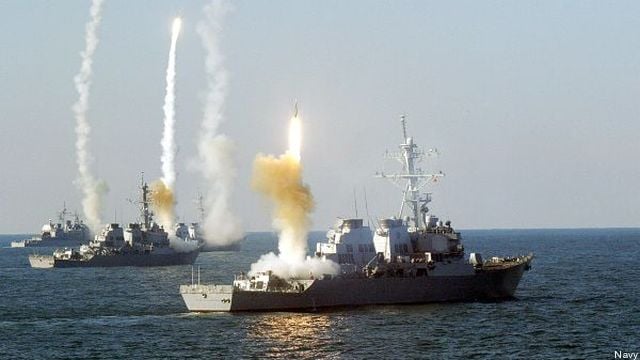
Aegis ships firing missiles
WASHINGTON: Warships from several NATO allies tracked and knocked down ballistic missile targets from the sea for the first time sharing targeting information across a shared alliance network.
The multinational, live-fire Formidable Shield exercise, which took place in May off the coast of Scotland, saw a French frigate knock down a supersonic target with an Aster 15 missile, while the Royal Canadian Navy tracked and hit another supersonic target with an Evolved Sea Sparrow missile. Both were firsts for the respective sea services.
The exercise, which simulated both ballistic and cruise missile threats, was a key test for integrating NATO’s sea forces across a single network that can push information across a deployed task force, something of incalculable importance in the confined spaces of Baltic Sea or North Atlantic if Russian missiles were launched from Kaliningrad or the Kola Peninsula.
“As we look for opportunities to expand our network of partnerships, we need to take care that our partners and allies can operate in our networks,” Kevin Gillis of the Navy’s Integrated Warfare Systems told the American Society of Naval Engineers. “This is a trend that’s here to stay and its confirmed by the number of cooperative deployments occurring with our allies …this is a key to success in the ‘fight tonight’ ethos our combatant commanders practice today.”
While the French and Canadians hit their targets as NATO AWACS aircraft cleared airspace around the drill, Formidable Shield also marked the first key test of a new NATO command and control structure, including the first at-sea deployment of Naples, Italy-based Commander Task Group 64, which runs the integrated air and missile defense mission for US Naval Forces Europe-Africa and the commander of 6th Fleet.
The 13-ship task force, which included Canada, Denmark, France, Italy, the Netherlands, Norway, Spain, UK and the US, merged tactical information using NATO’s Air Command and Control System to coordinate movements, Gillis said, and was able to link sea and shore-based units together — including a simulated Aegis Ashore unit which successfully simulated the launch of SM3 BlockIIA missiles at a ballistic target. Several allies were also able to track ballistic missile targets and share space tracks over tactical data links with the entire task group, Gillis added.
The Missile Defense Agency emulated threats for the exercise, while the US Air Force Europe used F-16s to launch AQM-37 supersonic target drones.
Speaking earlier in the day at the same conference, MDA chief Vice Adm. Jon Hill said it’s getting harder to track new ballistic and cruise missile threats as technologies mature more quickly and more countries develop their own capabilities.
“Speed is a big deal,” he said. “We are driven by the threat, and it is amazing what we’re up against … It is stunning. What also is stunning is how the threat is changing.” Working with the Navy is also a growing part of what his organization does, since sea-based deterrence is increasingly important. “Defense itself is deterrence … as a cost-imposing measure on the adversary.”
Questions hang over UK’s new, ambitious defense spending plan: Analysts
Such is the scale of British Army acquisition problems alone that they could not be resolved if the UK moved to a long term spending settlement of even 4 percent GDP, an expert told British lawmakers.


























